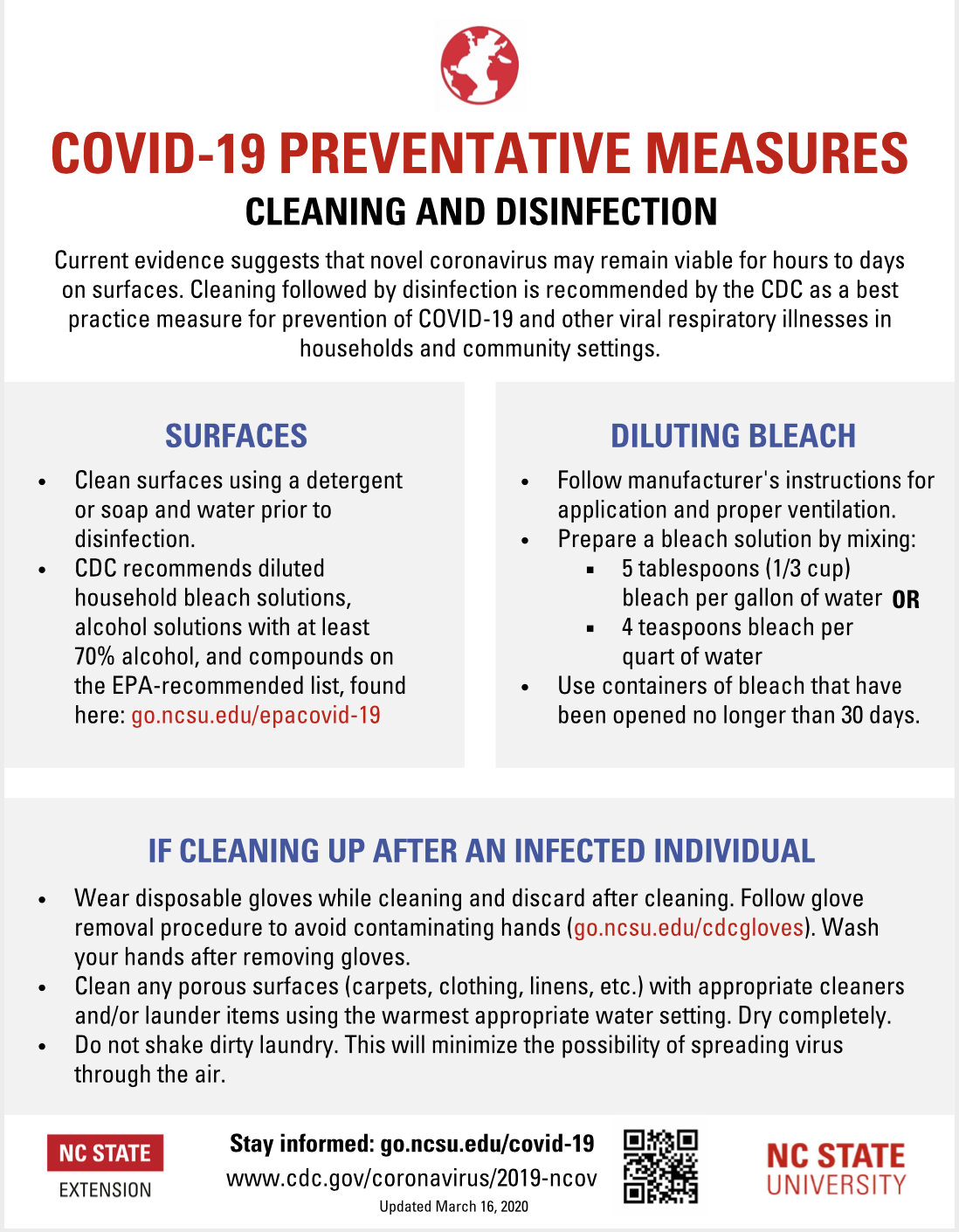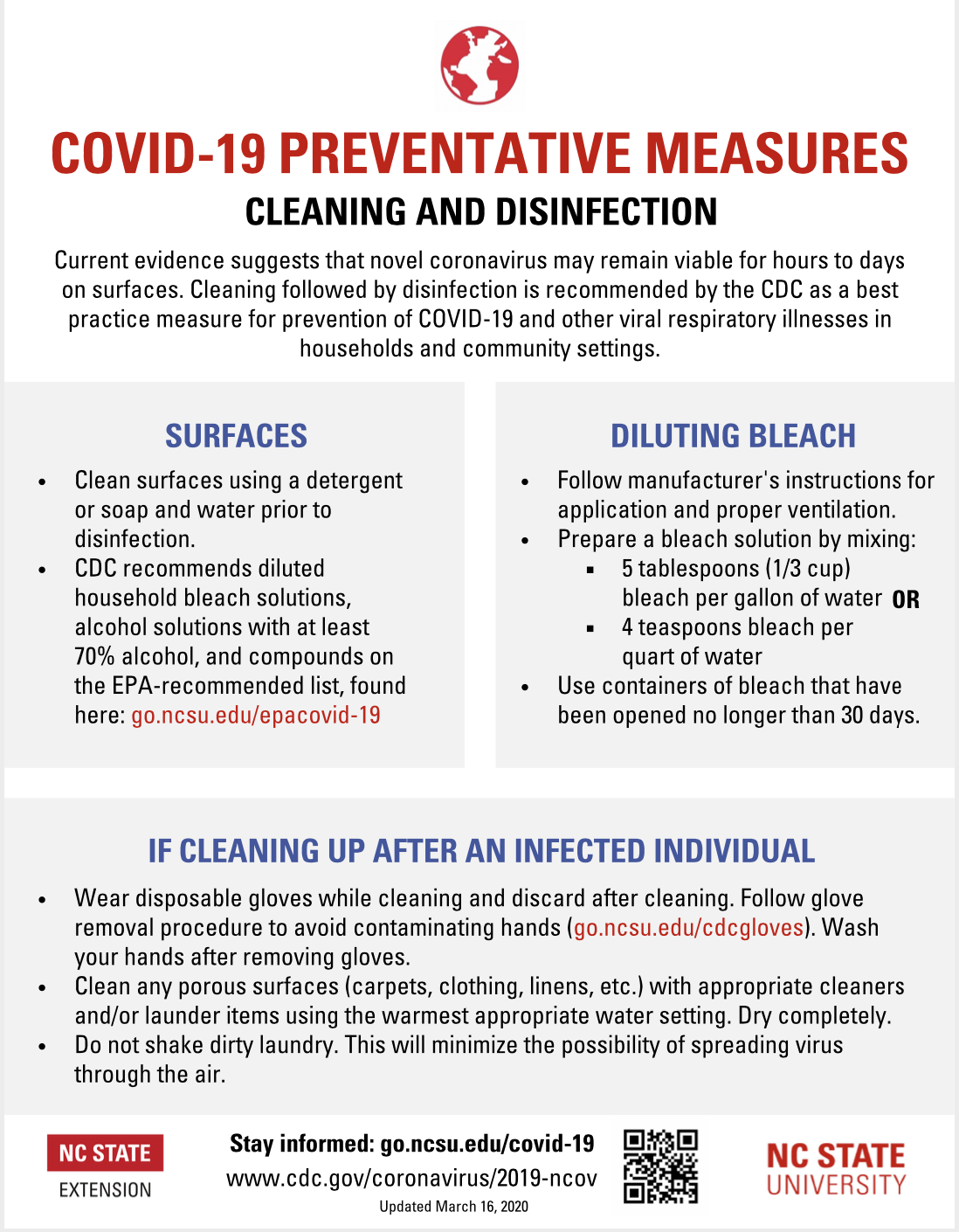Disinfecting and Sanitizing for COVID-19
go.ncsu.edu/readext?694893
en Español / em Português
El inglés es el idioma de control de esta página. En la medida en que haya algún conflicto entre la traducción al inglés y la traducción, el inglés prevalece.
Al hacer clic en el enlace de traducción se activa un servicio de traducción gratuito para convertir la página al español. Al igual que con cualquier traducción por Internet, la conversión no es sensible al contexto y puede que no traduzca el texto en su significado original. NC State Extension no garantiza la exactitud del texto traducido. Por favor, tenga en cuenta que algunas aplicaciones y/o servicios pueden no funcionar como se espera cuando se traducen.
Português
Inglês é o idioma de controle desta página. Na medida que haja algum conflito entre o texto original em Inglês e a tradução, o Inglês prevalece.
Ao clicar no link de tradução, um serviço gratuito de tradução será ativado para converter a página para o Português. Como em qualquer tradução pela internet, a conversão não é sensivel ao contexto e pode não ocorrer a tradução para o significado orginal. O serviço de Extensão da Carolina do Norte (NC State Extension) não garante a exatidão do texto traduzido. Por favor, observe que algumas funções ou serviços podem não funcionar como esperado após a tradução.
English
English is the controlling language of this page. To the extent there is any conflict between the English text and the translation, English controls.
Clicking on the translation link activates a free translation service to convert the page to Spanish. As with any Internet translation, the conversion is not context-sensitive and may not translate the text to its original meaning. NC State Extension does not guarantee the accuracy of the translated text. Please note that some applications and/or services may not function as expected when translated.
Collapse ▲We are entering Phase 2 of reopening North Carolina and as we do, we need to be sure that we are cleaning and disinfecting as a way of preventing and decreasing the spread of COVID-19. Measures such as staying home when ill, covering coughs and sneezes, and washing hands often are also needed. But as we reenter the workplace, cleaning, disinfecting, and sanitizing is of the utmost of importance. Additionally, understanding the difference between each of them is essential.
Cleaning — removes germs, dirt, and impurities from surfaces or objects. Cleaning works by using soap (or detergent) and water to physically remove germs from surfaces. This process does not necessarily kill germs but by removing them, it lowers their numbers and the risk of spreading infection.
Disinfecting — kills germs on surfaces or objects. Disinfecting works by using chemicals to kill germs on surfaces or objects. This process does not necessarily clean dirty surfaces or remove germs but by killing germs on a surface after cleaning, it can lower the risk of spreading infection.
Sanitizing — lowers the number of germs on surfaces or objects to a safe level, as judged by public health standards or requirements. This process works by either cleaning or disinfecting surfaces or objects to lower the risk of spreading infection.
As we return back to what will be our “new” normal, reducing the risk of exposure to COVID-19 by cleaning and disinfecting is an important part of reopening public spaces. Coronaviruses on surfaces and objects naturally die within hours to days. Warmer temperatures and exposure to sunlight will reduce the time the virus survives on surfaces and objects.
Some objects that are often touched will require daily disinfecting; these include countertops, tables, doorknobs, light switches, handles, desks, computer keyboards, phones, toilets, faucets, and sinks, gas pump handles, touch screens, and ATM machines. Here are the steps that are to be taken:
- First, clean the surface or object with soap and water.
- Then, disinfect using something EPA-approved.
- If an EPA-approved disinfectant is unavailable, you can use 1/3 cup of bleach added to 1 gallon of water or 70% alcohol solutions to disinfect. Do not mix bleach or other cleaning and disinfection products together. Bleach solutions will be effective for disinfection for up to 24 hours. Find additional information on CDC’s website on Cleaning and Disinfecting Your Facility.
Keep in mind the availability of cleaning and disinfection products and appropriate personal protective equipment (PPE). Always wear gloves appropriate for the chemicals being used for cleaning and disinfecting. Follow the directions on the disinfectant label for additional PPE needs.
Use the appropriate cleaning or disinfectant product; here is a link to the list of recommended disinfectants by the EPA approved disinfectants. When applied according to the manufacturer’s label, they are effective for use against COVID-19. Follow the instructions on the label for all cleaning and disinfection products for concentration, dilution, application method, contact time, and any other special considerations when applying.
Always follow the directions on the label to ensure the safe and effective use of the product. Many product labels recommend keeping the surface wet for a specific amount of time. The label will also list precautions such as wearing gloves and making sure you have good ventilation during the use of the product. And, always remember to keep all disinfectants out of the reach of children.
As we move forward in reopening, it will require us all to put into action the recommended best practices and to maintain safe daily habits in order to reduce our risk of exposure to COVID-19. Remember, we’re all in this together!
For more guidance on reopening, visit the Centers for Disease Control.
Below are several extension resources on cleaning and disinfecting.
For the most current information on Extension programs, like and follow us on Facebook at N.C. Cooperative Extension of Rowan County and you can also visit our website.
Toi N. Degree is family and consumer education agent with North Carolina Cooperative Extension. Contact her at 704-216-8970 or toi_degree@ncsu.edu.






